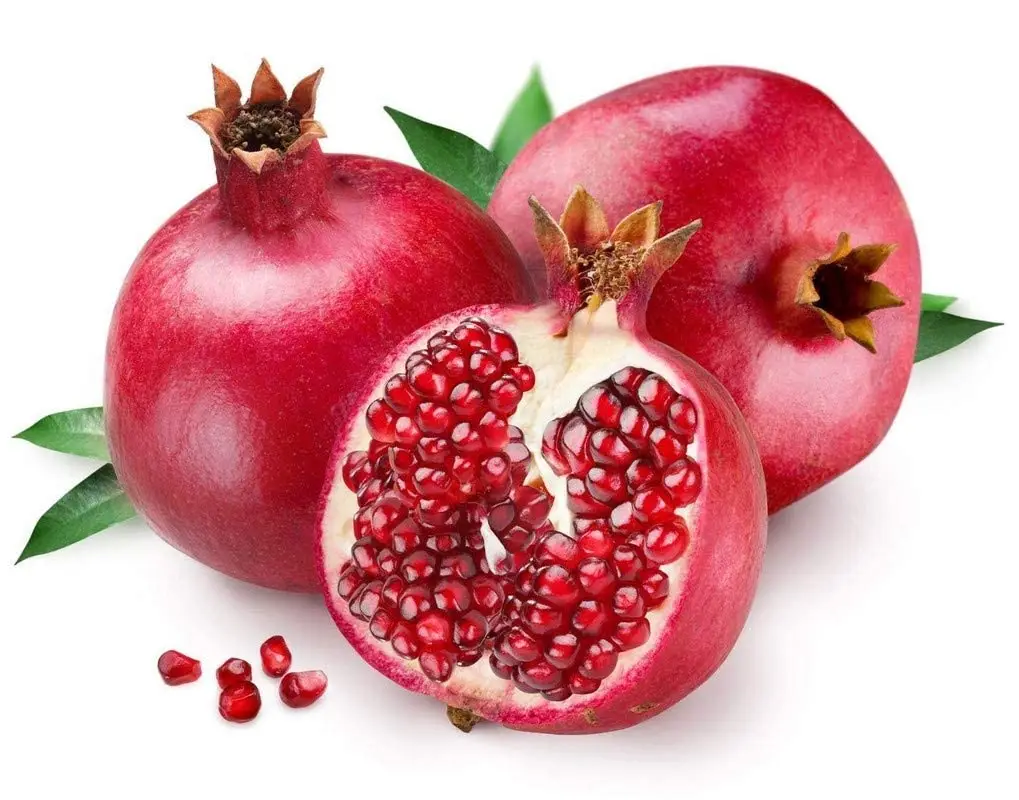The pomegranate (Punica granatum) is a fruit-bearing deciduous shrub in the family Lythraceae, subfamily Punicoideae, that grows between 5 and 10 m (16 and 33 ft) tall. The pomegranate is rich in symbolic and mythological associations in many cultures. The pomegranate is thought to have originated from Afghanistan and Iran before being introduced and exported to other parts of Asia, Africa, and Europe.[4][5][6]
It was introduced into Spanish America in the late 16th century and into California by Spanish settlers in 1769.[7] It is widely cultivated throughout West Asia and Caucasus region, South Asia, Central Asia, north and tropical Africa, the drier parts of Southeast Asia, and the Mediterranean Basin.[7] The fruit is typically in season in the Northern Hemisphere from September to February, and in the Southern Hemisphere from March to May.[8][9]
Pomegranate and juice are variously used in baking, cooking, juice blends, garnishes, non-alcoholic drinks, and cocktails.
The name pomegranate derives from medieval Latin pōmum ‘apple’ and grānātum ‘seeded’.[10] Possibly stemming from the old French word for the fruit, pomme-grenade, the pomegranate was known in early English as apple of Grenada—a term which today survives only in heraldic blazons. This is a folk etymology, confusing the Latin granatus with the name of the Spanish city of Granada, which is derived from an unrelated Arabic word.[11]
Garnet derives from Old French grenat by metathesis, from Medieval Latin granatum as used in a different meaning ‘of a dark red color’. This derivation may have originated from pomum granatum, describing the color of pomegranate pulp, or from granum, referring to ‘red dye, cochineal’.[12]
The modern French term for pomegranate, grenade, has given its name to the military grenade.[13]
Pomegranates were colloquially called wineapples or wine-apples in Ireland, although this term has fallen out of use. It still persists at the Moore Street open-air market, in central Dublin.[14][15]
Description
Pomegranate being trained as a bonsai
The pomegranate is a shrub or small tree growing 5 to 10 m (16 to 33 ft) high, with multiple spiny branches. It is long-lived, with some specimens in France surviving for 200 years.[7] P. granatum leaves are opposite or subopposite, glossy, narrow oblong, entire, 3–7 cm (1+1⁄4–2+3⁄4 in) long and 2 cm (3⁄4 in) broad. The flowers are bright red and 3 cm (1+1⁄4 in) in diameter, with three to seven petals.[7] Some fruitless varieties are grown for the flowers alone.[16]
Fruit
An opened pomegranate
Pomegranate flower
Fruit setting
The pomegranate fruit husk is red-purple in color with an outer, hard pericarp, and an inner, spongy mesocarp (white “albedo”), which comprises the fruit inner wall where seeds attach.[17] Membranes of the mesocarp are organized as nonsymmetric chambers that contain seeds which are embedded without attachment to the mesocarp.[17] Pomegranate seeds are characterized by having sarcotesta, thick fleshy seed coats derived from the integuments or outer layers of the ovule’s epidermal cells.[18][19] The number of seeds in a pomegranate can vary from 200 to about 1,400.[20]
Botanically, the fruit is a berry with edible seeds and pulp produced from the ovary of a single flower.[18] The fruit is intermediate in size between a lemon and a grapefruit, 5–12 cm (2–4+1⁄2 in) in diameter with a rounded shape and thick, reddish husk.[7]
In mature fruits, the juice obtained by compressing the seeds yields a tart flavor due to low pH (4.4) and high contents of polyphenols,[21] which may cause a red indelible stain on fabrics.[22] The pigmentation of pomegranate juice primarily results from the presence of anthocyanins and ellagitannins.[21][23]












Reviews
There are no reviews yet.